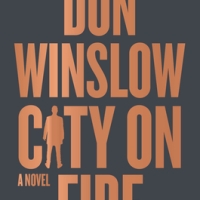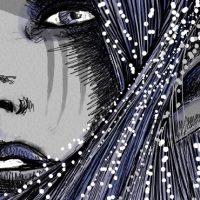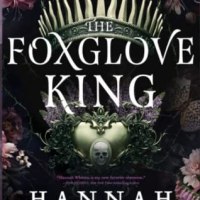Guest Post: “7 Secrets to Making Fascinating Monsters” by Laurence MacNaughton
 Today, we’re pleased to welcome back author Laurence MacNaughton to the BiblioSanctum to celebrate the release of Forever and a Doomsday, the fourth book in his Dru Jasper urban fantasy series! In this latest installment, our eponymous protagonist has found herself in possession of the powerful apocalypse scroll, an ancient artifact that can bring about the end of the world. To keep the scroll out of demonic hands, Dru and her friends must crack a millennia old mystery, follow its clues to a lost city in the netherworld, and unearth a crystal older than the Earth itself. I’ve been enjoying this series so much and I can’t wait to dive right back in to continue the adventure! In the meantime though, Laurence has so kindly written us a guest post on creating fascinating monsters, and what a fitting topic for October as we start ramping up for Halloween! We hope you enjoy his post, and be sure to check out the Dru Jasper series and Forever and a Doomsday, available on sale October 15!
Today, we’re pleased to welcome back author Laurence MacNaughton to the BiblioSanctum to celebrate the release of Forever and a Doomsday, the fourth book in his Dru Jasper urban fantasy series! In this latest installment, our eponymous protagonist has found herself in possession of the powerful apocalypse scroll, an ancient artifact that can bring about the end of the world. To keep the scroll out of demonic hands, Dru and her friends must crack a millennia old mystery, follow its clues to a lost city in the netherworld, and unearth a crystal older than the Earth itself. I’ve been enjoying this series so much and I can’t wait to dive right back in to continue the adventure! In the meantime though, Laurence has so kindly written us a guest post on creating fascinating monsters, and what a fitting topic for October as we start ramping up for Halloween! We hope you enjoy his post, and be sure to check out the Dru Jasper series and Forever and a Doomsday, available on sale October 15!
![]()
7 SECRETS TO MAKING FASCINATING MONSTERS
by Laurence MacNaughton
What would fantasy, science fiction, and horror be like without monsters? A well-crafted monster not only scares us, but also fascinates us. It captures our curiosity. It makes us want to peer deeper into the darkness that should make us want to run away.
An interesting monster has to be more than just terrifying — it also has to make a twisted kind of sense. The more real a monster seems, the deeper it affects us, because it grows into something more complex. It may even reveal a darker truth about human nature in general, and by extension, you and me in particular.
So how do writers go about creating truly unforgettable monsters?
Every writer is different. But I like to start with the word itself: M-O-N-S-T-E-R. Believe it or not, those seven letters spell out everything you need to know to make your own monster.
M is for Mind
Let’s say you’re creating a monster for your own story or game. You probably have a hazy idea of what sort of monster you want to create.
First question: how smart is your monster? How well does it think?
Is it dangerously cunning? Self-aware? Or just a mindless monstrosity?
There is no right or wrong answer here. You could go any way you choose.
Dumb monsters are most frightening if they are also incredibly dangerous, and single-minded in their pursuit of the heroes. Think of Jaws, for example.
Smart monsters are terrifying when they outwit our heroes, learn from mistakes, and lay traps for those who underestimate them. Think of something more like Predator.
O is for Origin
Where does your monster come from? What is its origin story? There are generally three kinds of monster origins, and they can have a strong impact on the theme of your story:
Monsters from the past (such as prehistoric creatures) remind us that human beings are not necessarily the apex predator of the world. If there’s something bigger and badder out there trying to eat us for dinner, that strikes us with a primal fear.
Monsters from another world or another dimension (such as ghosts, demons, or aliens) remind us that the universe is bigger than we think. These sorts of monsters destroy our sense of security and make the normal world around us feel unsafe.
Monsters that we create (sometimes in a laboratory, sometimes by accident) remind us that we can’t control the world around us. It turns the advantages of our technology into our biggest enemy. That’s frightening on many levels.
N is for Need
Let’s face it: monsters that exist solely to kill the heroes are pretty uninspiring. Sure, they can be scary, but they are utterly forgettable. What if your monster has a need beyond mere bloodthirstiness?
What if it’s trying to guard its territory? What if it’s trying to find or build a new nest? Reproduce? Defend or feed its young? Destroy competition for limited resources? Rejoin others of its kind?
Figure out what your monster really needs, and suddenly it becomes a fascinating creature.
S is for Sketch
If you have any artistic skills at all, why not draw a picture of your monster for inspiration?
If not, sketch it out with words. Think about what your monster looks like. Visualize it in your mind. Picture it moving through different environments.
How large or small is it, exactly? Does it have an angular head, long legs, wings, or other unusual features? Describe it.
What covers its body: fur, leathery skin, armored plates? Is it an unusual color or texture?
What does this monster sound like? What does it smell like?
How does it move? Does it slither, scuttle, or creep?
Write all of these things down. But here’s a super secret ninja author trick: whatever you do, don’t reveal your entire monster to the reader until much later in the story. Provide only glimpses here and there to build the suspense. People fear the unknown.
T is for Take On
At some point, this monster is going to come into direct conflict with the heroes. How can they take it on? How can they fight it? Or, failing that, how can they escape?
What could hurt this monster? What could scare it off?
Take some time at this one. Brainstorm. Think outside the box. This will lead you to new and interesting story possibilities that will keep your readers guessing.
E is for Eat
Why do so many monsters have long, gnashing teeth? Because getting eaten is one of our most basic fears. A monster that tries to devour you is instantly terrifying.
What’s in your particular monster’s diet? Maybe it doesn’t eat people. Maybe it drinks blood. Maybe it devours human souls. Or maybe it feeds on fear. It’s up to you.
R is for Relationships
It might be strange to think of “monsters” and “relationships” in the same sentence, but stick with me here. Even monsters have some sort of relationship to others of their kind. Are they loners, or do they form a pack? Do they have some kind of hierarchy?
Does this monster belong to someone? Does it obey them? If so, to what extent?
Could this monster control or rule over someone or something else?
Any of these could give you new story ideas.
Making Monsters for the Dru Jasper Series
In my Dru Jasper urban fantasy series, every book sees the heroes (all with strange and unique magic powers) fighting to save the world from the coming apocalypse. The latest book, Forever and a Doomsday, squares them off against the worst threat they’ve ever faced: a horde of undead wraiths who can walk through walls and kill with a mere touch.
Here’s how I created them with my M-O-N-S-T-E-R method:
- M is for Mind
These wraiths aren’t some kind of mindless undead. They are (or were) some of the smartest and most powerful sorcerers on the planet. If they weren’t ghastly creatures of the night bent on destroying the world, they’d probably make fascinating dinner party guests. That crafty intelligence makes them formidable opponents.
- O is for Origin
These creatures actually chose to become undead, for their own nefarious purposes. I can’t give away their big secret, but suffice to say they come from beyond our world. That makes the heroes realize that there are plenty of important things they don’t know, which makes the situation much more dangerous.
- N is for Need
Although these wraiths can drain your soul with a mere touch, that’s not their ultimate goal. They’re actually trying to get their hands on a powerful magical artifact, the apocalypse scroll, which would give them the power to destroy the world. Since the heroes have it, the wraiths will pursue them relentlessly.
- S is for Sketch
Here’s what the heroes first see:
A slender, luminous figure slipped through the night. It didn’t walk so much as glide through the darkness, and the eerie movement made her skin crawl. As if sensing her gaze, it jerked its head to look straight at her. But there was something hideously wrong with its face. It had no eyes. Nothing but twin pools of impenetrable blackness.
- T is for Take On
How do you fight something that has no physical body? You can’t shoot it or punch it. In this book, the main character is a crystal sorceress, and must find a crystal that can affect them. (I won’t give away the answer, but here’s a hint: since the wraiths come from beyond this world, the crystal must, too.)
- E is for Eat
What do these wraiths “eat”? Your soul. Nuff said.
- R is for Relationships
These wraiths are actually a tightly-knit team of villains. Back when they were alive, they were radical movers and shakers of the 1960s, doing everything they could to make the world a better place. When all of their efforts crashed and burned, they became so disenchanted that they set a plan in motion to destroy the world, wipe the slate clean and start over. And they are perilously close to succeeding.
Your Turn: Make a Monster
Remember, take time to think about each element and brainstorm new ideas. You don’t necessarily have to do them in order, but you should think about all of the elements. And above all, have fun making your own monsters!
I often teach this method as a workshop at writing conferences. If you have any questions about it, or you would like a free copy of my monsters guide and worksheet, just contact me through my author website at http://www.LaurenceMacNaughton.com.
![]()
Laurence MacNaughton is the author of more than a dozen novels, novellas, and short stories. He writes fast-paced books with spooky monsters, sweet romance, wry humor and outrageous car chases. His novels have been praised by Publishers Weekly, Booklist, Library Journal, and Kirkus Reviews. Laurence grew up in a 200-year-old haunted farmhouse and sold his first magazine article at age 19. Before he became a full-time writer, he worked as a professional prototype vehicle test driver. He lives in Colorado with his lovely wife and too many classic cars. Try his stories free at www.LaurenceMacNaughton.com
CONTACT
Website: https://laurencemacnaughton.com/
Goodreads: https://www.goodreads.com/author/show/6421258.Laurence_MacNaughton
Amazon: http://www.amazon.com/-/e/B008YIX5HA
Facebook: https://www.facebook.com/laurence.macnaughton
Twitter: https://twitter.com/LMacNaughton
















What a wonderful post and how interesting. I read the first book in this series when it first came out and loved it. I really do intend on going back and picking up the rest. I love the concept of the cars – it was so much fun. I really think more people should be giving this series a try!
LikeLike
It’s a great series! I’m glad you’ll continue 😀
LikeLike
Super clever post, and I had not thought of monsters this way before! It’s cool to see the development broken down this way😁
LikeLike
I know, such a creative way to lay it out!
LikeLike
Oh it looks perfect for me. I want to read it!
LikeLike
You would love this series!
LikeLike
Truly an intriguing post! Monsters have more depth than one dares to imagine, indeed… 🙂
Thank you so much for sharing!
LikeLike
Yes. Laurence’s post was great, I really appreciated the detail 😀
LikeLike
Awesome title as always 🙂
I want to create a monster too
LikeLike
I’d like to see what you come up with 😀
LikeLike
This is so good – really great advice and fascinating to read. Another upcoming read for me.
Lynn 😀
LikeLike
Pingback: Mogsy’s Bookshelf Roundup: Stacking the Shelves & Recent Reads | The BiblioSanctum
Pingback: Making Fascinating Monsters on The Bibliosanctum | LAURENCE MACNAUGHTON